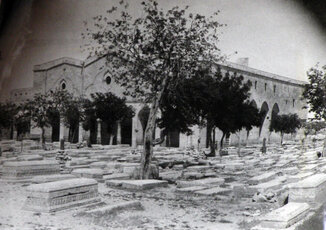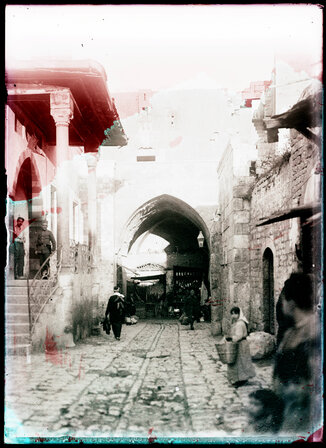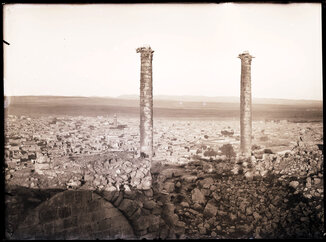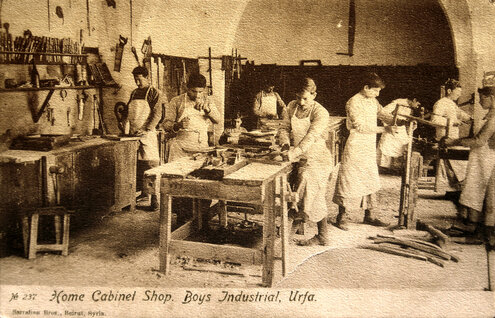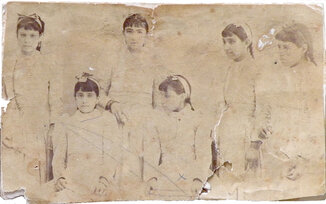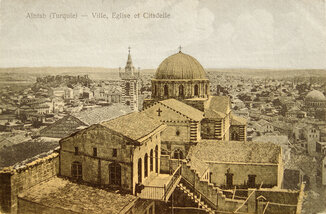Editorial note
Houshamadyan's editorial staff have already prepared articles about certain places in Aleppo province. This is the case of the Marash district (sandjak). To read these articles click on the title SANDJAK OF MARASH, to be found in the column on the left.
Province of Aleppo: Photo gallery
We present, in this section, pictures taken in the Aleppo vilayet (province), the majority of which are photographs and engravings relating to the Ottoman era. We have presented the province with its relevant various sub-sections with the object of making them more easily accessible. In the future we will present, alongside them, various themed articles prepared by the editorial board about the Aleppo province. Thus this method of presentation is of a temporary nature which will last until the articles have been prepared. It should be noted that we have worked on the old photographs in this section with the aim of improving their colour, tone and quality.
Sandjak of Urfa/Şanlıurfa
(See below for picture captions and sources)
Captions and sources
1) A scene in Urfa. (Source: Service historique de la Défense, Vincennes)
2) A fountain in a Muslim cemetery in Urfa, ca 1919-20 (Source: photograph by Father Gabriel Bretocq, Archives départementales de l’Eure. Fonds Gabriel Bretocq)
3) Urfa seen from a Muslim cemetery, ca 1919-1920 (Source: photograph by Father Gabriel Bretocq, Archives départementales de l’Eure. Fonds Gabriel Bretocq)
4) Urfa: the courtyard of a mosque, ca 1919-1920 (Source: photograph by Father Gabriel Bretocq, Archives départementales de l’Eure. Fonds Gabriel Bretocq)
5) A street in Urfa, ca 1919-1920 (Source: photograph by Father Gabriel Bretocq, Archives départementales de l’Eure. Fonds Gabriel Bretocq)
6) Urfa castle, seen from the mosque, ca 1919-1920 (Source: photograph by Father Gabriel Bretocq, Archives départementales de l’Eure. Fonds Gabriel Bretocq)
7) The Urfa mosque and Abraham’s lake, ca 1919-1920 (Source: photograph by Father Gabriel Bretocq, Archives départementales de l’Eure. Fonds Gabriel Bretocq)
8) The bridge and entrance to Urfa, ca 1919-1920 (Source: photograph by Father Gabriel Bretocq, Archives départementales de l’Eure. Fonds Gabriel Bretocq)
9) A scene from Urfa, ca 1919-1920 (Source: photograph by Father Gabriel Bretocq, Archives départementales de l’Eure. Fonds Gabriel Bretocq)
10) An engraving of Urfa (Source: Chesney, The expedition for the survey of the rivers Euphrates and Tigris, London, 1850)
11) A caravansary in Urfa (Source: Hugo Grothe, Geographische Charakterbilder, Leipzig, 1909)
12) Urfa castle, below which Father Abraham’s Lake is to be found (Source: Christine Gardon collection)
13) Urfa: The courtyard of St Sarkis monastery (Source: Christine Gardon collection)
14) Urfa: St Sarkis monastery (Source: Christine Gardon collection)
15) Urfa castle (Source: Christine Gardon collection)
16) Urfa’s Armenian Protestant church. Architect: Rev. Hagop Abuhhaiyatian (Source: Christine Gardon collection)
17) The town of Urfa seen from the south – from the castle (Source: Christine Gardon collection)
18) A scene from the town of Urfa (Source: Christine Gardon collection)
19) An interior view of the Urfa Armenian cathedral. (Source: Christine Gardon collection)
20) An interior view of the Urfa Armenian Protestant church. (Source: Christine Gardon collection)
21) The Urfa cathedral, courtyard and tombs. (Source: Christine Gardon collection)
NEW / NEW / NEW
NEW / NEW / NEW
Urfa, date unknown. Standing (from left): Khanum Ketenjian (participated in the 1915 Urfa resistance) and Hovhannes Attarian. Seated and dressed in Ottoman Army uniform: Armenag Attarian (the brother of Hovhannes; also participated in the resistance). Standing, with her hand on Aram’s shoulder: Khanum Attarian (Armenag’s wife). Standing directly behind the woman seated: Krikor Tashjian. The other individuals are unknown (Source: Vahé Tachjian collection, Berlin)
Captions and sources
23) Urfa market, ca 1919-1920 (Source: photograph by Father Gabriel Bretocq, Archives départementales de l’Eure. Fonds Gabriel Bretocq)
24) A street scene from Urfa, ca 1919-1920 (Source: photograph by Father Gabriel Bretocq, Archives départementales de l’Eure. Fonds Gabriel Bretocq)
25) A street scene from Urfa, ca 1919-1920 (Source: photograph by Father Gabriel Bretocq, Archives départementales de l’Eure. Fonds Gabriel Bretocq)
26) Urfa Muslim cemetery, ca 1919-1920 (Source: photograph by Father Gabriel Bretocq, Archives départementales de l’Eure. Fonds Gabriel Bretocq)
27) A scene from the Armenian quarter of Urfa, ca 1919-1920 (Source: photograph by Father Gabriel Bretocq, Archives départementales de l’Eure. Fonds Gabriel Bretocq)
28) Urfa, seen from the castle, ca 1919-1920 (Source: photograph by Father Gabriel Bretocq, Archives départementales de l’Eure. Fonds Gabriel Bretocq)
29) The Urfa bridge, ca 1919-1920 (Source: photograph by Father Gabriel Bretocq, Archives départementales de l’Eure. Fonds Gabriel Bretocq)
Captions and sources
30) Urfa. The Attarian family. Standing (center, back row): Apraham Attarian (killed in 1915) (Source: Vahé Tachjian collection)
31) Urfa, funeral. The Attarian family. Seated in center, wearing a fez, is Apraham Efendi Attarian. (Graduated Central Turkey College, Ayntab, in 1886. Worked as a chief druggist in the Urfa German Hospital. Killed in 1915). Seated (from left): Yeghsa Tashjian (née Attarian). Standing next to her is Annush ‘kuruk.’ The names of the others are unknown (Source: Vahé Tachjian collection)
Sandjak of Marash/Kahramanmaraş
(See below for picture captions and sources)
Captions and sources
1) Bridge over the Djihan/Ceyhan River (Source: W.J. Childs, Across Asia Minor on Foot, Edinburgh/London, 1917)
2) An engraving of Marash (Source: E.J. Davis, Life in Asiatic Turkey, London, 1879)
3) The town of Marash (Source: Hugo Grothe, Geographische Charakterbilder, Leipzig, 1909)
4) The German Mission hospital, Marash (Source: Hugo Grothe, Geographische Charakterbilder, Leipzig, 1909)
5) The town of Elbistan on the banks of the Djihan (Ceyhan) River (Source: Hugo Grothe, Geographische Charakterbilder, Leipzig, 1909)
6) An official ceremony in Marash (Source: Mark Sykes, Dar-ul-Islam, London, 1904)
7) Elbistan: the Muslim cemetery appears in the foreground (Source: Hugo Grothe, Geographische Charakterbilder, Leipzig, 1909)
8) Armenian Protestant notables of Marash (Source: Ferdinand Brockes, Quer durch Klein-Asien, Gütersloh, 1900)
Caza of Ayntab/Gaziantep
(See below for picture captions and sources)
Captions and sources
1) An engraving of Ayntab (Source: Chesney, The expedition for the survey of the rivers Euphrates and Tigris, London, 1850)
2) Ayntab: the wheat market (Source: W.J. Childs, Across Asia Minor on Foot, Edinburgh/London, 1917)
3) Ayntab, 1911. The Armenian Protestant church choir. Standing (from left): Nerses Barsoumian, Rosa Beredjikian/Barsoumian, 3rd and 4th (unknown), Mari Levonian, Adour Levonian, Hripsime Levonian/Laleyan, Aleksan Bezdjian, Victoria Levonian, Beatrice Danelian, Levon Levonian. Seated (from left): Mariam, Azniv Demirdjian, Vartouhi Loshkhadjian, Rosa Hovnanian, Mari Sarkisian, Beatrice Nazarian, Mari Krikorian, Nouritsa Levonian, Khachadourian. Seated on floor (from left): Efronia Nazarian (later Khatchadourian), Yervant Nazarian (Efronia's brother), Zekie Levonian, Levon Levonian (Zekie's brother), Alice Bezdjian, Rosa Haleblian, Djemil Haleblian (Source: Joyce Abdulian collection)
4) Ayntab: the identities of those in the photograph have still to be determined (Source: Joyce Abdulian collection)
5) Ayntab. Central Turkey College. Armenian female pupils. Seated, center (from left): Anna Tashjian (from Urfa) (Source: Vahé Tachjian collection)
6) Crossing the Euphrates by boat (Source: Hugo Grothe, Geographische Charakterbilder, Leipzig, 1909)
7) The town of Ayntab (Michel Paboudjian collection)

Hovhannes Effendi Levonian’s family in Ayntab. Standing, left to right: Zekie, Yakub, Levon, Mihran. Seated, left to right: Dudu (mother), Yervant, Dudu’s mother, Hovhannes Effendi (father) (Source: Joyce Abdulian collection)
Caza of Zeytun/Süleymanlı
(See below for picture captions and sources)
Captions and sources
1) The town of Zeytun photographed in the rain (Source: W.J. Childs, Across Asia Minor on Foot, Edinburgh/London, 1917)
2) A scene from Zeytun (Source: W.J. Childs, Across Asia Minor on Foot, Edinburgh/London, 1917)
3) Zeytun photographed from the south west (Source: Hugo Grothe, Geographische Charakterbilder, Leipzig, 1909)
4) Zeytun photographed from the southern summit (Source: Hugo Grothe, Geographische Charakterbilder, Leipzig, 1909)
5) Zeytun (Source: Hugo Grothe, Geographische Charakterbilder, Leipzig, 1909)
6) In a street in Zeytun (Source: Hugo Grothe, Geographische Charakterbilder, Leipzig, 1909)
7) The Ottoman army barracks constructed close to the town of Zeytun (Source: Mark Sykes, Dar-ul-Islam, London, 1904)
8) A bridge on the road to Zeytun (Source: Mark Sykes, Dar-ul-Islam, London, 1904)
9) An Armenian woman from Zeytun (Source: Mark Sykes, Dar-ul-Islam, London, 1904)
10) Group photograph of Armenian orphans in Zeytun (Source: Ferdinand Brockes, Quer durch Klein-Asien, Gütersloh, 1900)
11) Zeytun: Baba Agha (on the left), one of the town’s Armenian notables, and his sons (Source: Ferdinand Brockes, Quer durch Klein-Asien, Gütersloh, 1900)
12) Zeytun: Inside the house of the Armenian notable Baba Agha (Source: Ferdinand Brockes, Quer durch Klein-Asien, Gütersloh, 1900)
Sandjak of Aleppo
(See below for picture captions and sources)
Sandjak of Antakya
(See below for picture captions and sources)





















